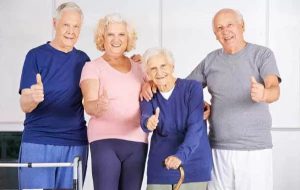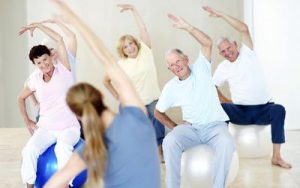By Alicia Frey
Did you know approximately 30% of community dwelling older adults fall every year?1 Falls are also the leading cause of injury related deaths and hospital emergency department visits2.
Why do we fall as we get older?
The most commonly reported reason for falling is ‘accidental’ which is defined as an inability to safely navigate around an environment and avoid a fall after an unexpected slip or step3. The second most common reason for falls include gait or balance disorders. Research has also shown that previous fall history and knee osteoarthritis are the two single biggest predictors for future falls4.
After the first fall, there is a 66% chance of having another fall within a year5. This is partly due to the increased fear of falling leading to reduced activity which in turn leads to physical deconditioning and a subsequent increased risk of falls6.

How can I reduce the risk of falls?
Evidence shows exercise programs that challenge lower limb strength and balance and are completed for at least 2 hours/week have been shown to reduce falls by 42% in the community-dwelling older adult7.
How can Physiohealth help?
Physiohealth run a falls and balance class, ‘Able and Stable Victoria’, which aims to improve individuals’ lower limb strength and balance with the overall aim of reducing the risk of falls. These group gym circuit classes run for 60 minutes once per week with a qualified physiotherapist. The program also includes a pre and post balance assessment. For more information, including class times, please contact your nearest clinic.

Other factors to consider to further reduce falls risk at home:
• Environmental hazards that can be removed or avoided, including tripping obstacles such as cords, rugs, and furniture; slippery surfaces; and poorly it areas.
• Accessories that can be installed and furniture that can be modified to facilitate transfer or walking including ramps, proper height toilet seats and beds, grab bars next to the toilet and shower, and railings along walking pathways.
• Assistive devices such as falls monitoring devices or rescue alert systems5.
References
1. Deandrea S, Lucenteforte E, Bravi F, Foschi R, La Vecchia C, Negri E. Review Article: Risk Factors for Falls in Community-dwelling Older People:” A Systematic Review and Meta-analysis”. Epidemiology. 2010 Sep 1:658-68.
2. Evans JA, van Wessem KJ, McDougall D, Lee KA, Lyons T, Balogh ZJ. Epidemiology of traumatic deaths: comprehensive population-based assessment. World journal of surgery. 2010 Jan 1;34(1):158.
3. Rubenstein, L. Z. (2006). Falls in older people: epidemiology, risk factors and strategies for prevention. Age and ageing, 35(suppl_2), ii37-ii41.
4. Swanenburg, J., de Bruin, E. D., Uebelhart, D., & Mulder, T. (2010). Falls prediction in elderly people: a 1-year prospective study. Gait & posture, 31(3), 317-321.
5. Lusardi, M. M., Fritz, S., Middleton, A., Allison, L., Wingood, M., Phillips, E., … & Chui, K. K. (2017). Determining risk of falls in community dwelling older adults: a systematic review and meta-analysis using posttest probability. Journal of geriatric physical therapy (2001), 40(1), 1
6. Vieira, E. R., Palmer, R. C., & Chaves, P. H. (2016). Prevention of falls in older people living in the community. bmj, 353(1), 1419
7. Sherrington C, Tiedemann A, Fairhall N, Close JC, Lord SR. Exercise to prevent falls in older adults: an updated meta-analysis and best practice recommendations. New South Wales public health bulletin. 2011 Jun
